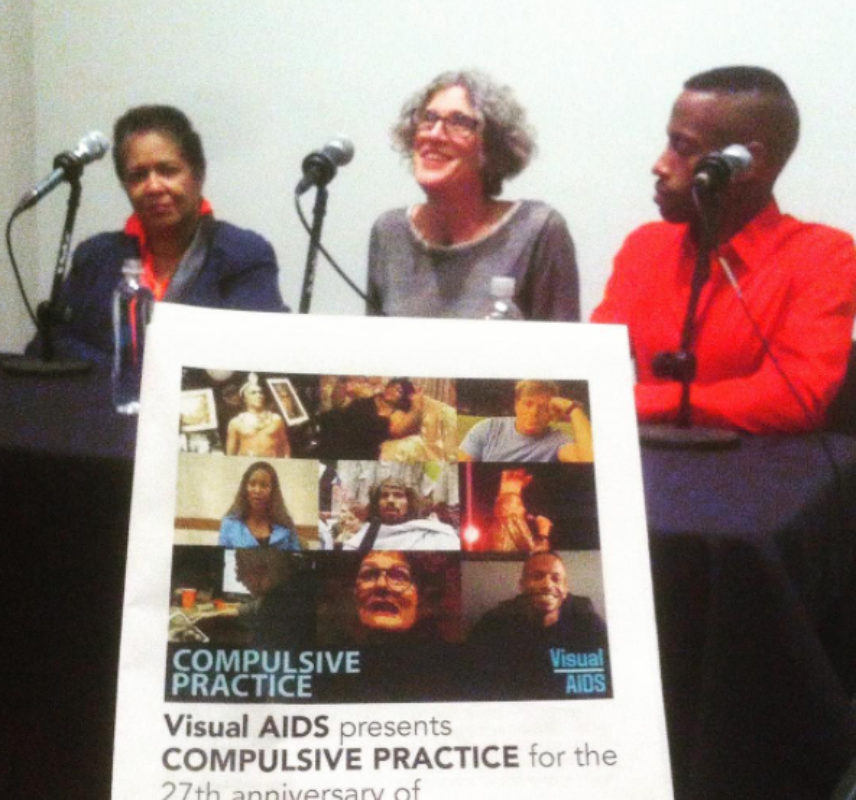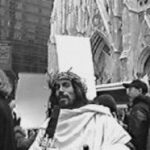Past Event
COMPULSIVE PRACTICE: Brooklyn Museum First Saturdays
Brooklyn Museum, Sackler Center Forum





Visual AIDS screened COMPULSIVE PRACTICE for Day With(out) Art at the Brooklyn Museum's First Saturday event. The screening was followed by a conversation with the artists Juanita Mohammed and Justin B. Terry-Smith, moderated by Alexandra Juhasz, Brooklyn College Film Department Chairperson, and co-curator of Everyday and COMPULSIVE PRACTICE. The screening was introduced by Day With(out) Art Project Manager / Brooklyn College MA Candidate Kyle Croft.
COMPULSIVE PRACTICE is an hour-long video compilation of compulsive, daily, and habitual practices by nine artists and activists who live with their cameras as one way to manage, reflect upon, and change how they are deeply affected by HIV/AIDS.
From video diaries to civil disobedience, holiday specials and backstage antics, Betamax to YouTube, COMPULSIVE PRACTICE displays a diversity of artistic approaches, experiences, and expectations. The compulsive video practices of these artists serve many purposes—cure, treatment, outlet, lament, documentation, communication—and have many tones—obsessive, driven, poetic, neurotic, celebratory. COMPULSIVE PRACTICE will demonstrate the place of technology, self-expression, critique, and community in the many decades and the many experiences of artists and activists living with HIV/AIDS.
COMPULSIVE PRACTICE highlights subjects ranging from historic actions against government neglect to contemporary issues such as Pre-Exposure Prophylaxis (PrEP) and living with an undetectable viral load. Altogether, the program charts over three decades of AIDS-related video production in the face of the ongoing crisis.
Participating video makers and artists include Juanita Mohammed, Ray Navarro (1964–1990), Nelson Sullivan (1948–1989), the Southern AIDS Living Quilt, James Wentzy, Carol Leigh aka Scarlot Harlot, Luna Luis Ortiz, Mark S. King, and Justin B. Terry-Smith. COMPULSIVE PRACTICE is curated by Jean Carlomusto, Alexandra Juhasz, and Hugh Ryan, in conjunction with the Visual AIDS exhibition Everyday.
Sponsored by a Humanities New York Vision/Action Grant.
Excerpt: “It is so beautiful to see your faces in this time of national disaster. Because you reflect back to us the beauty of our communities and our intersecting communities. Which, I think, is one of the things that the tape argues, it didn't know that t***p would win. In our intersecting community and the vitality of our love and our difference is every minute of that tape and it's in this room. We are the people who matter, who are real to ourselves and to each other. This work is about testifying to that. Your presence watching the work is about testifying to that” - Alexandra Juhasz
Excerpt: "I'm in my house taking my camera with me to get the milk. You never know what you might catch!" -Juanita Mohammed
Excerpt: “Your compulsion to make art. Your compulsion to tell your stories, your experiences with AIDS and otherwise, with your family, with children feeds our activism in so many ways. And that's true for all of our artists." -Alexandra Juhasz
Excerpt: “Giving a testimony of what was going on with me was able to manifest itself and have other people say 'well this is happening with me too'. Having people comment and send me emails about that made me want to do more and more. And broadened my horizon like my husband and I are adopting this kid and another kid. I'm still doing this and thinking of what it means to be positive. And a lot of people from the older generations would say well, we never thought that would even be a possibility.” - Justin B. Terry-Smith
Excerpt: "Activists wanted to make a video of women. So I volunteered to come and after 6 weeks we would be there every Saturday. Positive, non-positive women, medical women. Originally we thought it would just be filming. But we would just end up talking, sharing our problems. We became families and we came back and talked about our videos. " -Juanita Mohammed
Excerpt: “As far as me growing up and going to college I kind of left it by the wayside but I always really had a passion for journalism in the media and so being a writer today really did help me to be able to be open about what I have. To be open about who I am. But I will say that I have two sons they are 20 and 18. And I will say that I LOVE social media... It does allow them to be open and to explore and explain their feelings to the outside world. It does allow us to be able to say 'here's an important cause'. Here's an avenue for you to feel passionate about, go explore that." - Justin B. Terry-Smith
Excerpt: "If something was happening, a protest at two o'clock in the morning, I was there. Every penny that I had would go into making my videos. Now that I've gotten older I've forgotten the activism, it's not as strong as it was... Now I can barely go out, I'm on dialysis but now I can make the time again to go out there and do that because there's people that need to be led... AIDS needs to be brought forth by the younger people and the older people who have the history" -Juanita Mohammed
PANEL PARTICIPANTS
Alexandra Juhasz (moderator) has been making and thinking about AIDS activist video since the mid-80s. She is the author of AIDS TV: Identity, Community and Alternative Video (Duke, 1995), and a large number of AIDS educational videos including Living with AIDS: Women and AIDS (with Jean Carlomusto, 1987), Safer and Sexier: A College Student's Guide to Safer Sex (1991), and Video Remains (2005). Most recently she’s been engaging in online cross-generational dialogue with AIDS activists and scholars about the recent spate of AIDS imagery after a lengthy period of representational quiet.
Juanita Mohammed is a community video artist and activist. She uses inexpensive camcorder video technology to respond to the needs of those who matter to her. In her work at the Gay Men’s Health Crisis in New York City, Mohammed makes educational videos for and about the AIDS community. In her personal video work, she looks to her friends and neighbors to find stories that are not typically represented in the media.
Justin B. Terry-Smith, M.P.H., is a noted HIV and gay civil rights activist and the creator of "Justin's HIV Journal," a popular blog in which he shares his trials and tribulations of living with HIV. A U.S. Air Force veteran, Justin resides in Laurel, Maryland, with his husband, Dr. Philip Terry-Smith, and their sons, Lundyn and Tavis. Presently, Justin is working toward earning his doctorate in public health. Find him at www.justinbsmith.com
ABOUT THE ARTISTS
Mark S. King has written about living with HIV since testing positive when the test became publicly available in 1985. His blog, www.MyFabulousDisease.com, chronicles his life as an HIV positive gay man in recovery from addiction. He is also the author of A Place Like This, his memoir of life in Los Angeles during the dawn of the AIDS epidemic.
Carol Leigh aka Scarlot Harlot has been working as a sex worker/prostitute activist and artist in the Bay Area for more than thirty years. Since the late seventies, she has written and performed political satire as "Scarlot Harlot," and produced work in a variety of genres on queer and feminist issues including work based on her experience in San Francisco massage parlors. A "Mother" of the sex workers rights movement, she is credited with coining the term sex worker. Her recent work and archives are available at sexworkermedialibrary.org
Juanita Mohammed is a community video artist and activist. She uses inexpensive camcorder video technology to respond to the needs of those who matter to her. In her work at the Gay Men’s Health Crisis in New York City, Mohammed makes educational videos for and about the AIDS community. In her personal video work, she looks to her friends and neighbors to find stories that are not typically represented in the media.
Ray Navarro (1964-1990) was an artist, filmmaker and activist. He attended Cal Arts in California and moved to New York in 1988 to go to the Whitney Independent Study Program, and soon joined ACT UP (AIDS Coalition To Unleash Power). He was also a member of DIVA TV (Damned Interfering Video Activists), a video-documenting affinity group of ACT UP. DIVA TV documented public testimony, the media, and community activism to motivate the fight against AIDS.
Luna Luis Ortiz was born in New York City in 1972. In 1986, he was infected with HIV at the age of 14 from his first sexual experience. In 1988, he began his journey as an HIV awareness spokesperson for youth living with HIV at the Hetrick-Martin Institute, and has worked at Gay Men's Health Crisis since 2007. He then studied photography at the School of Visual Arts and has worked with the photographers David LaChapelle, Lisa Ross, Shedrich Williames and Nan Goldin. The Luna Show is a show about the voguing scene and the people involved in the House/Ball community, one of the hardest hit communities by the ongoing HIV/AIDS epidemic. The Luna Show has been viewed by 2 million people worldwide.
The Southern AIDS Living Quilt is a project that illustrates the growing impact of HIV on women in the southern U.S., particularly women of color. Using video testimonials, the Living Quilt shares the personal stories of women living with HIV, their families and health care providers throughout the region. The stories underscore the critical importance of making HIV screening a routine part of medical care in order to ensure earlier diagnosis and prevent the spread of the disease.
Nelson Sullivan (1948-1989) was a video artist in New York City during the 1980s. Nelson lived in a large townhouse at 5 Ninth Avenue in the Meatpacking District of New York City and his houseguests over the years included Lady Bunny, Michael Alig and the Club Kids, Sylvia Miles, Albert Crudo, and John Sex. Nelson's friendships with the emerging artists of that day like RuPaul, Deee-lite, Scott Wittman and Marc Shaiman give Nelson's videos an intimacy that allows the viewer an in-crowd look at the past.
Justin B. Terry-Smith, M.P.H., is a noted HIV and gay civil rights activist and the creator of "Justin's HIV Journal," a popular blog in which he shares his trials and tribulations of living with HIV. A U.S. Air Force veteran, Justin resides in Laurel, Maryland, with his husband, Dr. Philip Terry-Smith, and their sons, Lundyn and Tavis. Presently, Justin is working toward earning his doctorate in public health. Find him at www.justinbsmith.com
James Wentzy is an AIDS activist and documentary filmmaker associated with ACT UP throughout the 1990s. He has been producer director and editor for the weekly series AIDS Community Television (aka DIVA TV) since 1991, producing over 160 documentary programs, his own feature-length documentary Fight Back, Fight AIDS, and documented over 700 hours of actions and demonstrations, conferences, and the communities’ cultural and artistic responses to AIDS. His footage frequently appears in others’ media documentaries. He worked as video archivist for the Estate Project’sAIDS Activist Video Preservation Project at the New York Public Library.
ABOUT THE CURATORS
Jean Carlomusto was an early pioneer in the AIDS Activist video movement. Her most recent works include the Emmy-nominated documentary, Larry Kramer In Love & Anger (Sundance Film Festival and HBO, 2015), Sex In An Epidemic (Showtime, 2011), and Offerings (an interactive altar featured in the traveling international exhibition, “Not Alone”, Stop AIDS / Make Art, 2010). She continues to create critically acclaimed films that explore the unorthodox complexities of LGBTQ history.
Alexandra Juhasz has been making and thinking about AIDS activist video since the mid-80s. She is the author of AIDS TV: Identity, Community and Alternative Video (Duke, 1995), and a large number of AIDS educational videos including Living with AIDS: Women and AIDS (with Jean Carlomusto, 1987), Safer and Sexier: A College Student's Guide to Safer Sex (1991), and Video Remains (2005). Most recently she’s been engaging in online cross-generational dialogue with AIDS activists and scholars about the recent spate of AIDS imagery after a lengthy period of representational quiet.
Hugh Ryan is a freelance writer and curator whose work explores the intersection of queer identity, history, and culture. His writing has appeared in venues from like The New York Times, Buzzfeed, Out Magazine, and The LA Review of Books, and he has spoken on queer museology at museums and universities around the world, including the Museum of History and Industry, Rutgers University, New York University, the Swedish Exhibition Agency & National Museum, and The Brooklyn Museum. He is the Founding Director of the Pop-Up Museum of Queer History and currently sits on the Board of Advisors for QED: A Journal in GLBTQ Worldmaking, and is the New York Public Library's 2016-2017 Martin Duberman Visiting Scholar, where he is researching the queer history of the Brooklyn waterfront for a 2017 exhibition he is curating at the Brooklyn Historical Society.
Related Events
Day With(out) Art 2016: COMPULSIVE PRACTICE |
Thursday, December 1, 2016 |
Studio Screen: COMPULSIVE PRACTICE at The Studio Museum in Harlem |
Sunday, December 4, 2016 from 3:00pm–5:00pm |


